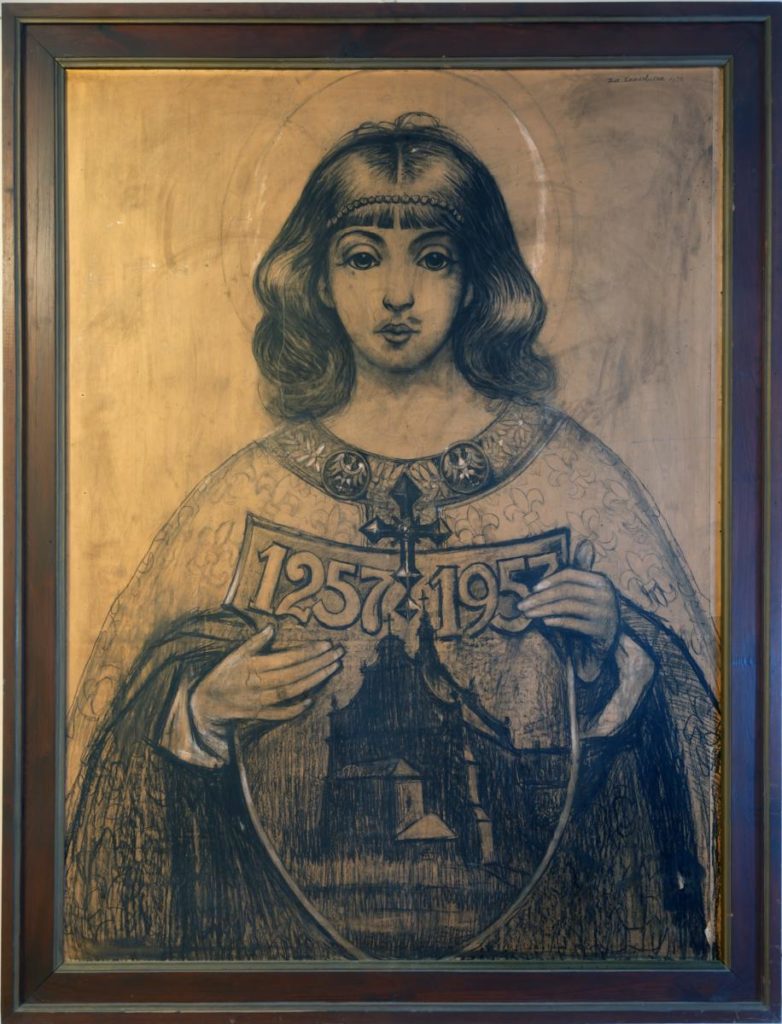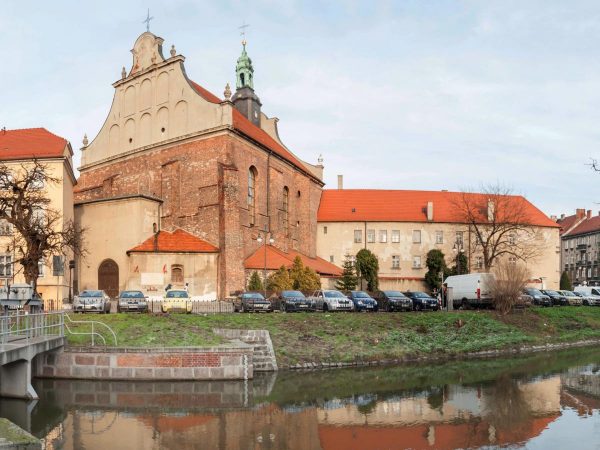Wooden monuments
Hungarian princess
While visiting the church of the Franciscans in Kalisz, it is worth to take a few moments to muse about an extraordinary benefactress – the blessed Yolanda. She was a Hungarian princess, a daughter of king Bela IV of the Arpads dynasty, a younger sister of Saint Kinga (the wife of prince Boleslaw the Chase). After being married to prince Boleslaw the Pious, she became famous for numerous foundations (churches of St. Stanislaus, and St. Nicholas in Kalisz, the convent of Poor Clares in Gniezno among others). After her husband’s death, instead of living the life of a dowager duchess, Yolanda became a humble nun and she wore the Clarisses’ habit.

160 years ago, monks built a chapel of the blessed Yolanda, where they placed an altar dedicated to her in the second part of the 18th century. In the altar’s crowning, there is a coat of arms in a cartouche of the founder, Piotr Sapieha, with a so called gloria above it (a decoration which refers with its form to a monstrance) with an image of a dove.
A copy of the painting of the blessed Yolanda hangs in a decorative gold frame. And just below the artwork, one can see a small coffin-reliquary where Yolada’s ashes are kept: a fragment of pelvis and one of her vertebra. In June 1958 the ashes came here from Gniezno thanks to the onetime guardian of the convent, father Adam Narloch, with the permission of the primate cardinal Stefan Wyszyński.
Blessed Yolenda, shown in a Clarisses’ habit, instead of royal insignia, is holding her new “sceptre” – a cross. She is gazing towards the Holy Book. In the background, behind a spread curtain, a cityscape of Kalisz with a silhouette of the church of the Franciscans is seen. Above the church, an image of flagellated Christ has been shown.
In the monastery’s corridors which are unavailable for tourists there is one other image of the Duchess. It is a painting from 1923. The work is a peculiar book from which much can be read. It shows “the blessed Yolanda of St. Clara’s order, a wife of Bolesław the Pious, Duke of Kalisz”. The Duchess was portrayed because of her “foundation of the Order of Friars Minor of the convent of Kalisz and the church of St. Stanislaus”.
Coat of arms of Franciscan Order of Friars Minor
Coat of arms of Kalisz whose patron saint is Blessed Yolanda
Duchess is holding a model of the convent of Poor Clares which was founded by her initiative in Gniezno in 1283.

Monumental St. Christopher

During conservation works in the chancel of the church of the Franciscans in Kalisz, an image of St. Christopher has been revealed. The painting was made with a mix technique on a very thin plaster. It is around 16 meters high and is preliminary dated to the turn of the 13th and 14th centuries, or to the first half of the 14th century. The saint is holding Baby Jesus on his left arm, and with his right he is wielding a stick with flowers on top. The way the face and the figure of St. Christopher are painted is extremely interesting – the face is shown from a front view and it shows the mastery of the artist which refers to the Byzantine painting. This sensational discovery can change the current research on Gothic wall painting in Greater Poland region.
Meticulously painted music gallery
An historical object of particular importance is the music gallery with the pipe organs. The oldest mention about it can be found in the chronicles of the monastery from 1644. According to sources, Anna Śmiglowa donated a large sum of money for the renovation of the pipe organs in the main nave. The current double-case is made in the Baroque style. It consists of three sets of pipes with lanterns, on the top of which sculptures of the “angel choir” are set, and between the sets, pipe panels can be found. Originally, the case had wings which closed the panels, which can be deducted from the remains of hinges on sides, however, those were replaced with late-Baroque chambranles in the first half of the 18th century.

An outstanding element is a late-Renaissance gallery with a wooden balustrade, which was covered with paintings. It was divided into two rows: the upper row shows the images of saints, and the bottom one was decorated with extremely finesse landscapes.


Fishing for men’s souls
Preaching has always played a very important role for the Franciscans. In order for the preachers to be well seen and heard, a suitable position was necessary – a pulpit (Polish: ambona, from Greek step, elevate). During ages they have taken different shapes.
In Franciscan church, pulpit has taken a very sophisticated form of St. Peter’s boat. Many preachers delivered passionate sermons above “the sea of heads” of the faithful.
The pulpit was constructed in 1862. Hung high above the floor, according to artists’ plans, it was to focus attention. The voice of the speaker was heard in every corner of the church. The “basket” of the pulpit which bounced off sounds was responsible for that.
- Papal coat of arms: a tiara with crossed keys below – the attribute of St. Peter, the first Pope (the following bishops of Rome are his successors).
- Nets – a fishreman’s attribute.
- The figurehead, the ship’s prow decoration, in the shape of an angle playing the trumpet.
- Stairs which lead to the pulpit situated on “the prow”.
Simon Peter, i.e. St. Peter the Apostle, was a special Fisherman. It was to him that Christ himself said: “Don’t be afraid; from now on you will fish for people” (Luke 5, 10-11).


Confessio, a confession of sins
Probably under the influence of moving sermons many of the faithful took the sacrament of penance. Since the Council of Trent (16th century) confessional has been the place where they could confess their sins. In every period, the confessional took less or more complex shapes.
Beautiful, almost 250 year-old confessionals in the late Baroque style are found at the Franciscans’, which have been moved here from an old Jezuit church among others.


- The symbolism of a heart in flames and IHS monogram (from Greek: Jesus Christ) on the confessional indicates its Jesuit origin. The Jesuits emphasized the Sacrament of Penance and Reconciliation.
- Many secrets and mysteries could be told by effaced kneelers, which were used by the people who would confess there and and openwork wall through which they confessed their sins.
This type of confessional is a result of the experience with wood which artist-monks gained. The confessional was supposed to look monumental and at the same time to ensure intimacy and concentration for the faithul during the act of confession.
Indulgences
8 maja (św. Stanisława Biskupa)





